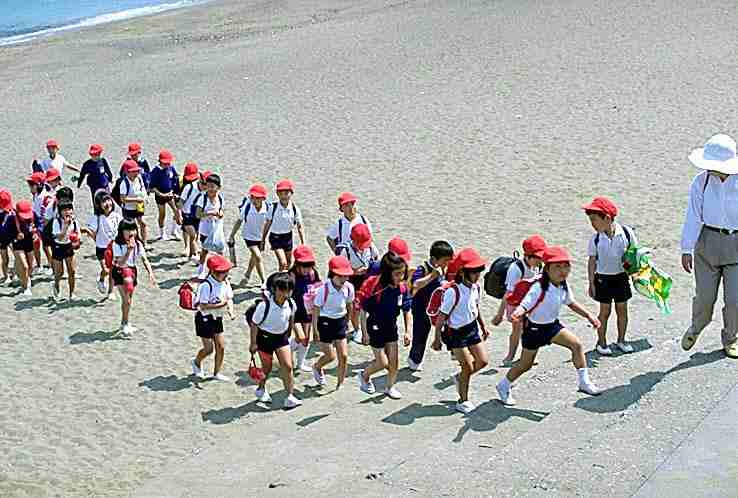
Figure 1.--Here we see a Japanese school group on a field trip to a beach. This seems to be more of a recreational trip than an educational one. Note the bright red caps. |

|
We have only limited information at this time as to the sites or activities to which children went on these field trips. Hopefully our Japanese readers will provide us some details on popular field trips. School field trips to sites such as fire stations are popular in some countries, especially for younger children. I'm not sure if this is the case in Japan. Some of the popular attractions seem to be museums and historical temples and shires. We also notice outings to beaches and other outdoor sites which seem to be more of a recreational activity than a learning experience.
Trips to Government buildings in the West such as the Capitol, White House, Buckingham Palaces, etc. are field trip mainstays. You wouls assume that the same woul be true in Japan as well with fied trips to the Diet, Emperor's Palace, and local givernment buildings. We have, however, little information about this. We see children on front of the Diet. We do not know if the children's representative met with them and if there are tours inside the building.
Museum trips seem to be a field trip mainstay. We have very little information, however, on Japanese museums at this time. Given the duration and richness of Japanese civilization, there must be some fascinating museums in the major cities.
Nature outings are another fabvrite field trip activity, especially for younger children. Children are of course fascinated by animals and nature. Thus children love these nature outings. Japan is a very heavily urbanized country. This somewhat limits nature outings. hus teachers have to be creative for some of these outings.
School field trips to sites such as fire stations are popular in some countries, especially for younger children. I'm not sure if this is the case in Japan.
Some of the most important historical trasures in Japan are fabulous castles. These castles were enormous forts as well as palaces. Here the samuri of the Shogun, Emperor and the Daimo struggled to control the country. Thet are enormous and solid, but archetecularly elegant structurs--unlike anything in any other country. Some were destroyed in battle and fires, but many survived and are located in carfully cared for parks. One of the most fabeled in Suri castle. Given their historical importance and story book appearance, they make for wonderful field trips. And of course the children wanted to be photographed with the palaces in the background.
We seem to notice quite a few recreational outings in Japan. The beach outing here seems to be an example of that (figure 1). Outings to parks are another favorite here.
Japan is not a very religious country, but there are many graceful shrines and temples located throughout the country. Many important Japanese parks are built around these buildings and many are visited by school children. I'm not sure when these field trips began. I do not know how common field trips were during the pre-World War II period. This is an interesting question because until after World War II, Shinto was the state religion. Thus the character of school trips to Shinto shrines would have been very different than after the War. Shinto was not banned during the American occupation, but the character of the religion chganged when the Emperor abandoned his divine status. As Shinto was essengially a religion based on veneration of the Emperor it had to channge. In addition it staus as the established state religion chnged. I am not sure just how school visits to Shinto shrines are approached. I supose they are now more like historical trips, but Shinto still exists as an active religion, as is Budhism. So schools trips appear to have a mixed approach with historical, religious, and patriotic commonents.
Related Chronolgy Pages in the Boys' Historical Web Site
Late 19th century]
[The 1930s]
[The 1940s]
[The 1930s]
[The 1940s]
[The 1950s]
[The 1960s]
[The 1970s]
[The 1980s]
Navigate the Boys' Historical Clothing School Uniform Pages
[Main Japanese School Field Trip Page]
[Main Japanese School Activities Page]
[Australia]
[England]
[France]
[Germany]
[Ireland]
[Italy]
[Japan]
[New Zealand]
[Scotland]
[United States]
Related Style Pages in the Boys' Historical Web Site
[Long pants suits]
[Short pants suits]
[Socks]
[Eton suits]
[Jacket and trousers]
[Blazer]
[School sandals]
Navigate the HBC School Section:
[Return to Main school field trip page]
[Return to Main school page]
[About Us]
[Activities]
[Chronology]
[Clothing styles]
[Countries]
[Debate]
[Economics]
[Garment]
[Gender]
[Hair]
[History]
[Home trends]
[Literary characters]
[School types]
[Significance]
[Transport and travel
[Uniform regulations]
[Year level]
[Other topics]
[Images]
[Links]
[Registration]
[Tools]
[Return to the Historic Boys' School Home]
